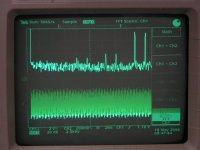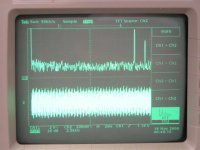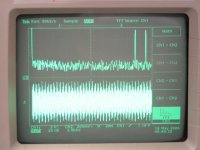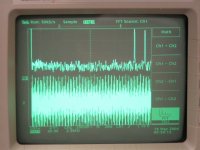somthing here is not right...
linear interpolation distorts the signal...
what are the stop and start frequencies on the FFT?
linear interpolation distorts the signal...
what are the stop and start frequencies on the FFT?
your aliasing the input to the FFT causing errors...
need to see the NOS DAC with the 8th order filter...
need to see the NOS DAC with the 8th order filter...
FFT analysis
FFT picture 5 (last one)
D-I DAC with 8th order filter, note the slight drop in the rightmost peak.
The filtered NOS-DAC and D-I DAC have much in common on the FFT scan, exept the slight drop in the rightmost peak. The FFT analysis shows that the spectrum is much clearer than the NOS-DAC without filter. It also shows that the unfiltered D-I DAC has a cleaner spectrum than the unfiltered NOS-DAC. So if you don't want to use a 8th order filter, the D-I DAC seems a good alternative.
But why does a NOS-DAC / D-I DAC sound more natural than a CD player with oversampling and digital interpolation filters?
Personally I think it has to do with both, a clean spectrum (to bring out detail) and phase linearity (to make it sound more natural, realistic just as real live sounds). Small tolerances in phase linearity can make a big difference. By avoiding filters that have non linear phase response, sound quality should improve.
FFT picture 5 (last one)
D-I DAC with 8th order filter, note the slight drop in the rightmost peak.
The filtered NOS-DAC and D-I DAC have much in common on the FFT scan, exept the slight drop in the rightmost peak. The FFT analysis shows that the spectrum is much clearer than the NOS-DAC without filter. It also shows that the unfiltered D-I DAC has a cleaner spectrum than the unfiltered NOS-DAC. So if you don't want to use a 8th order filter, the D-I DAC seems a good alternative.
But why does a NOS-DAC / D-I DAC sound more natural than a CD player with oversampling and digital interpolation filters?
Personally I think it has to do with both, a clean spectrum (to bring out detail) and phase linearity (to make it sound more natural, realistic just as real live sounds). Small tolerances in phase linearity can make a big difference. By avoiding filters that have non linear phase response, sound quality should improve.
Attachments
FFT setting
Hi, poobah,
Thanks for your reply. The screen indicates 2.5KHz/div (bottom-left corner on the oscilloscope screen). So the scan is DC-25KHz. The peaks on the right are the 21KHz and the mirror image on 23.1 KHz (21KHz mirrored to Fs/2). So basically we are looking at the entire audiorange.
Hi, poobah,
Thanks for your reply. The screen indicates 2.5KHz/div (bottom-left corner on the oscilloscope screen). So the scan is DC-25KHz. The peaks on the right are the 21KHz and the mirror image on 23.1 KHz (21KHz mirrored to Fs/2). So basically we are looking at the entire audiorange.
FFT explanation
Hi, all
Perhaps for some of you these FFT analysis are confusing, what do they indicate?
What the FFT analysis shows us what frequencies are present in the audio signal when we apply a single 21KHz (44.1 KHz sampled) sinewave to the DAC. The first peak at the right is the 21KHz sinewave we applied, the second peak next to it is the 23.1KHz mirrored image around half the sample frequency (Fs/2). When brickwall filtering is used the mirror image peak amplitude drops. When all is ok this is all what you should see, if there are more peaks (as with the unfiltered NOS-DAC's) this means addittional (undesired) harmonics are added to the audio spectrum, these tend to cover up "detail". But the FFT scans also show that these can be reduced by a non-brickwall phaselinear filter (8th order filter as used in this example). The amplitude modulation that occurs with the NOS-DAC's is simply a side effect of the low sampling frequency as rfbrk pointed out.
So what can we do to improve the D-I DAC or NOS-DAC? just add a phaselinear filter (Bessel) that filters out most of the unwanted harmonics (see FFT analysis). In this way we can still preserve phase linearity ensuring realistic sound reproduction.
Hi, all
Perhaps for some of you these FFT analysis are confusing, what do they indicate?
What the FFT analysis shows us what frequencies are present in the audio signal when we apply a single 21KHz (44.1 KHz sampled) sinewave to the DAC. The first peak at the right is the 21KHz sinewave we applied, the second peak next to it is the 23.1KHz mirrored image around half the sample frequency (Fs/2). When brickwall filtering is used the mirror image peak amplitude drops. When all is ok this is all what you should see, if there are more peaks (as with the unfiltered NOS-DAC's) this means addittional (undesired) harmonics are added to the audio spectrum, these tend to cover up "detail". But the FFT scans also show that these can be reduced by a non-brickwall phaselinear filter (8th order filter as used in this example). The amplitude modulation that occurs with the NOS-DAC's is simply a side effect of the low sampling frequency as rfbrk pointed out.
So what can we do to improve the D-I DAC or NOS-DAC? just add a phaselinear filter (Bessel) that filters out most of the unwanted harmonics (see FFT analysis). In this way we can still preserve phase linearity ensuring realistic sound reproduction.
Why use the TDA1541A? With a 20 bit dac and the appropriate hardware one can build the equivalent of 16 dacs.Even if one must remain with the TDA1541A, one can cut the 8 dac version to 2 dacs and still retain the data rate.
rfbrw said:
Standard digital techniques will recover the 20Khz sinewave from a 44k1 sample rate through the very ringing that seems so objectionable to some. Combined with the correct analogue filter, pre and post ringing recreates the sinewave.
Linear interpolation simply joins the sample points with straight line. At 2K you have 20+ samples, enough for a fair representation of the original waveform. At 20k, with only two samples, simply joining the sample points misrepresents the original waveform.
1/ in the real world, we don't listen to sine or square waves at 20kHz
2/ with only 2 sample points, no amount of ringing, interpolation, theories etc will distinguish between a sine , triangle or square wave !
Perhaps the minimum difference between filtered outputs of NOS DAC and DI DAC was caused by the fact, that the 21 kHz signal and its mirror 23 kHz are very close frequencies and the 8th grade filter attenuates the 23kHz signal only by 5dB if tuned to 21kHz (if I get the calculation right which may not be the case 🙂 ). Maybe a 15kHz signal would give a different result.
poynton said:
2/ with only 2 sample points, no amount of ringing, interpolation, theories etc will distinguish between a sine , triangle or square wave !
You are wrong. Beyond that, there is little else to say.
IF the original signal was properly filtered at fs/2 AND the reconstruction chain features brick wall LP filter at fs/2 THEN just two samples should be enough for a perfect sine shape at just below fs/2. However, I doubt the latter is the case in real world with NOS DAC and analogue filter.
The former can never be the case either. The original analog signal needs to be bandwidth limited before sampling using an analog filter. So anyhow you will end up having some aliasing in the resulting signal.
regards
Martti
regards
Martti
Martti, thanks for your info. What if we sample the input signal at e.g. 192kHz and decimate to 44.1kHz? That way we would have the steep antialiasing filter for 44.1kHz samples in digital domain which is presumably easier to make (I do not know about its impact on sound quality though).
Sorry for my offtopics, I just find this issue fascinating and remotely relevant to DI DAC.
Sorry for my offtopics, I just find this issue fascinating and remotely relevant to DI DAC.
That is probably one way to minimize aliasing. The following blog has some views on this:
http://eli.thegreenplace.net/2006/05/10/antialiasing-filteres-and-multirate-systems/
I tend to agree with some posters here (poobah, rfbrw) that linear interpolation may not be the best solution to this NOS problem (if there is a problem to begin with). If NOS with linear interpolation sounds better than plain NOS, then OS with proper digital filtering should at least theoretically sound much better than linear interpolation. However that does not always seem to be the case.
http://eli.thegreenplace.net/2006/05/10/antialiasing-filteres-and-multirate-systems/
I tend to agree with some posters here (poobah, rfbrw) that linear interpolation may not be the best solution to this NOS problem (if there is a problem to begin with). If NOS with linear interpolation sounds better than plain NOS, then OS with proper digital filtering should at least theoretically sound much better than linear interpolation. However that does not always seem to be the case.
First, you are not seeing a reduction in the mirror frequency... you are seeing in increase in the 21 kHz. That makes sense because linear interpolation will cause errors at 21 kHz. It will also cause errors (increases) at the 2nd harmonic, 42 kHz, as well.
Perhaps repeating the test with a 0 to 50 kHz sweep would reveal this.
Linear interpolation injects false (incorrect) data into the stream... that is the long and the short of it.
As to why it sounds better... you must consider the positive effect that averaging 4 DACs has on linearity error; you may be seeing a 3 to 12 dB (extreme theoretical limits) improvement in linearity... and that goes along way toward improving detail.
The effects of the linear interpolation are the most pronounced as the signal approaches fs/2. The effect are probably insignificant below fs/4.
My point is, don't look to the linear interpolation to explain the improvement in sound.


Perhaps repeating the test with a 0 to 50 kHz sweep would reveal this.
Linear interpolation injects false (incorrect) data into the stream... that is the long and the short of it.
As to why it sounds better... you must consider the positive effect that averaging 4 DACs has on linearity error; you may be seeing a 3 to 12 dB (extreme theoretical limits) improvement in linearity... and that goes along way toward improving detail.
The effects of the linear interpolation are the most pronounced as the signal approaches fs/2. The effect are probably insignificant below fs/4.
My point is, don't look to the linear interpolation to explain the improvement in sound.


so many posts now on the supposed effect of interpolation versus paralelling, I cant keep track... 
Let me come back to my earlier question than...
Is the reference DAC also paralleling 4 dacs in the output?
And the interpolation DAC is doing the same with time shifted samples?
and that would be the ONLY difference ?
In that case we can exclude the paralelling as the (only) reason why it would sound better and "must" the better sound has to do with the interpolation...
If not, than we do not compare aples with aples..
"So what it is it? and lets keep our peace forever"

Let me come back to my earlier question than...
Is the reference DAC also paralleling 4 dacs in the output?
And the interpolation DAC is doing the same with time shifted samples?
and that would be the ONLY difference ?
In that case we can exclude the paralelling as the (only) reason why it would sound better and "must" the better sound has to do with the interpolation...
If not, than we do not compare aples with aples..
"So what it is it? and lets keep our peace forever"
Octal DAC / Analysis
Hi, all
I have been very busy today. I found a test CD image on the internet containing LIN and LOG sweeps, Fixed sinewaves from 16...20KHz and sample sounds. So I ran numerous tests, then I couldn't wait anymore and decided to build the octal DI-DAC version with both the breadboard model and the DAC circuit board I showed in previous posts. When I switched it on: huge distortion (' ') . Rechecked the wiring, but that seemed to be ok.
') . Rechecked the wiring, but that seemed to be ok.
Then I remembered, the increased current (16mA for each I/V converter) caused the diff-amp to clip. I reduced the resistor values of all 4 I/V stages from 450 to 220 Ohms and switched on again, what I heard then can hardly be described. You must hear it yourself. It's an understatement to say it sounded realistic.
I looked at sinewaves of different frequencies to see if I could see the step size, nothing, then I put the attenuator to the lowest setting, still no steps. So I selected a sinewave of 16 KHz, as I expected the samples were connected with a straight line, due to linear interpolation, (still no steps). This was measured without filter. The error caused by linear interpolation is present, no doubt, this has already be pointed out by poobah. By using a separate I/V stage for every DAC group with different gain settings this could theoretically be corrected, but tests should be done first to see if it works and how it would improve sound quality.
Then the FFT tests with the NOS-DAC's and a CD player using different sinewave frequencies and sweeps:
1) Problems occur when approaching Fs/2, the distortion looks like intermodulation. Lower frequencies look much better.
2) The CD player also showed the mirror image despite brickwall filtering, but it had a lower amplitude. It also had ripple but at a higher frequency. But when applying fixed frequencies and sweeps, harmonics occured in the audio spectrum. These didn't show up with the NOS-DAC's using the 8th order filter.
Hi, all
I have been very busy today. I found a test CD image on the internet containing LIN and LOG sweeps, Fixed sinewaves from 16...20KHz and sample sounds. So I ran numerous tests, then I couldn't wait anymore and decided to build the octal DI-DAC version with both the breadboard model and the DAC circuit board I showed in previous posts. When I switched it on: huge distortion ('
 ') . Rechecked the wiring, but that seemed to be ok.
') . Rechecked the wiring, but that seemed to be ok. Then I remembered, the increased current (16mA for each I/V converter) caused the diff-amp to clip. I reduced the resistor values of all 4 I/V stages from 450 to 220 Ohms and switched on again, what I heard then can hardly be described. You must hear it yourself. It's an understatement to say it sounded realistic.
I looked at sinewaves of different frequencies to see if I could see the step size, nothing, then I put the attenuator to the lowest setting, still no steps. So I selected a sinewave of 16 KHz, as I expected the samples were connected with a straight line, due to linear interpolation, (still no steps). This was measured without filter. The error caused by linear interpolation is present, no doubt, this has already be pointed out by poobah. By using a separate I/V stage for every DAC group with different gain settings this could theoretically be corrected, but tests should be done first to see if it works and how it would improve sound quality.
Then the FFT tests with the NOS-DAC's and a CD player using different sinewave frequencies and sweeps:
1) Problems occur when approaching Fs/2, the distortion looks like intermodulation. Lower frequencies look much better.
2) The CD player also showed the mirror image despite brickwall filtering, but it had a lower amplitude. It also had ripple but at a higher frequency. But when applying fixed frequencies and sweeps, harmonics occured in the audio spectrum. These didn't show up with the NOS-DAC's using the 8th order filter.
- Home
- Source & Line
- Digital Line Level
- Building the ultimate NOS DAC using TDA1541A



